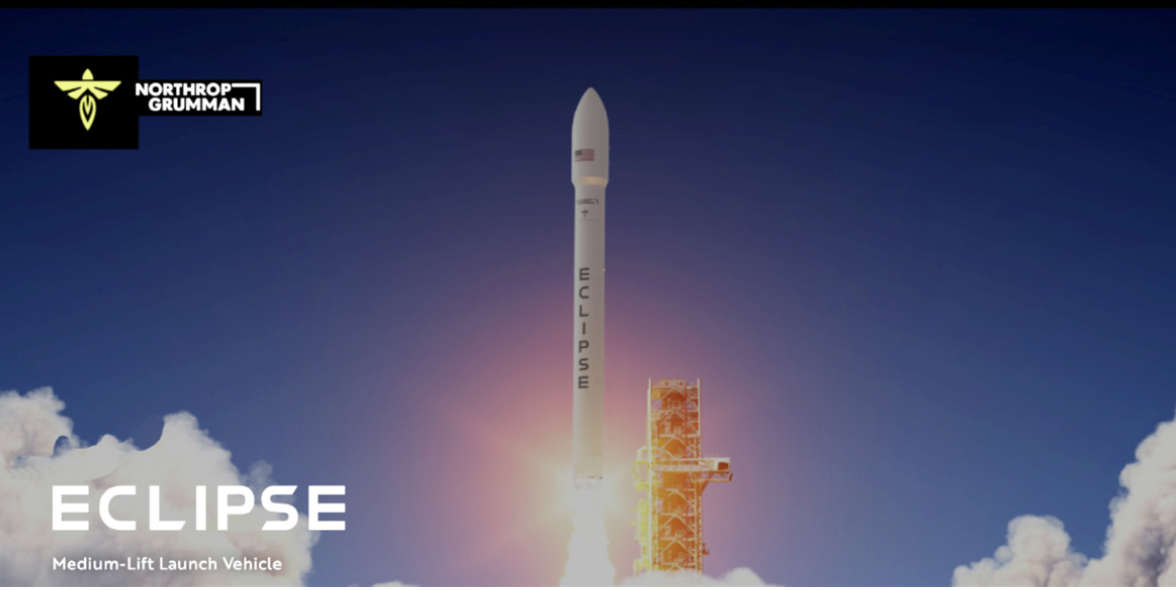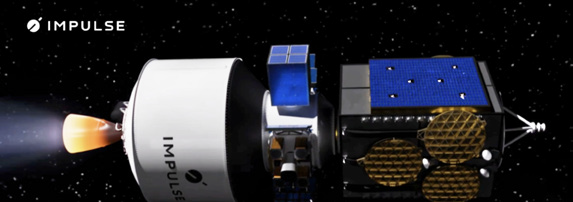Northrop Grumman invests $50 million In Firefly Aerospace to advance Eclipse™ medium launch vehicle
Northrop Grumman Corporation (NYSE: NOC) has invested $50 million into Firefly Aerospace to further advance production of the companies’ co-developed medium launch vehicle, now known as Eclipse™.
Filling a void in an underserved market, Eclipse will launch up to 16,300 kg of cargo to Low Earth Orbit or 3,200 kg of cargo to geosynchronous transfer orbit. Eclipse will first launch from Wallops Island, Virginia, and be able to support space station resupply, commercial spacecraft, critical national security missions and scientific payloads for the domestic and international markets.
 Built on Northrop Grumman’s Antares and Firefly’s Alpha rocket, Eclipse offers a significant leap in power, performance, production cadence and payload capacity. The launch vehicle retains the flight-proven avionics from Antares while delivering additional performance upgrades, including a larger 5.4 meter-class payload fairing. Eclipse also retains a scaled-up version of Alpha’s propulsion systems and carbon composite structures, allowing the team to rapidly build and test Eclipse with significant production efficiencies and economies of scale.
Built on Northrop Grumman’s Antares and Firefly’s Alpha rocket, Eclipse offers a significant leap in power, performance, production cadence and payload capacity. The launch vehicle retains the flight-proven avionics from Antares while delivering additional performance upgrades, including a larger 5.4 meter-class payload fairing. Eclipse also retains a scaled-up version of Alpha’s propulsion systems and carbon composite structures, allowing the team to rapidly build and test Eclipse with significant production efficiencies and economies of scale.
Firefly used the same patented tap-off cycle architecture from Alpha’s Reaver and Lightning engines for Eclipse’s Miranda and Vira engines, and completed mission duty cycle with a 206-second Miranda hot fire test, matching the longest time the engine will burn during a flight. Following several development test campaigns, flight hardware has been manufactured for the common dome propellant tanks, engine bay and interstage.
Eclipse is manufactured in Briggs, Texas, and Chandler, Arizona, and uses the same first stage Firefly is developing for the Northrop Grumman Antares 330 rocket. Both launch vehicles will use seven of Firefly’s Miranda engines.
Eclipse qualification testing is underway, with flight hardware developed, more than 60 Miranda engine hot fire tests performed to date and a targeted first launch no earlier than 2026.
Wendy Williams, vice president and general manager, launch and missile defense systems, Northrop Grumman, said, “Eclipse gives customers the right balance of payload capacity and affordability. Our partnership with Firefly builds on our capacity to provide crucial spaced-based communication, observation, and exploration for civil and national security customers.”
Jason Kim, CEO, Firefly Aerospace, said, “Firefly is incredibly grateful for Northrop Grumman’s investment that further solidifies our first-of-its-kind partnership to build the first stage of Antares 330 and jointly develop Eclipse. Eclipse represents two powerful forces coming together to transform the launch market, with decades of flight heritage and a rapid, iterative approach and bold innovation. With a 16 metric ton to orbit capability, Eclipse is a sweet spot for programs like NSSL Lane 1 and a natural fit to launch proliferated constellations in LEO, MEO, GEO and TLI.”
CubeSpace showcases high volume production for constellation builders
CubeSpace (CS) continues to announce record-setting production milestones that further solidify its position as a trusted partner for constellation builders globally.
 Over the last several months, CS has maintained a steady manufacturing rate of 40 reaction wheels per week, in parallel with its other product lines, as well as fully tailored ADCS (Attitude Determination and Control) systems. Notably, the company has been able to achieve these consistently high outputs, while maintaining average lead times of under three months.
Over the last several months, CS has maintained a steady manufacturing rate of 40 reaction wheels per week, in parallel with its other product lines, as well as fully tailored ADCS (Attitude Determination and Control) systems. Notably, the company has been able to achieve these consistently high outputs, while maintaining average lead times of under three months.
This strong momentum was especially evident in February, when CS shipped more than 300 ADCS-related products to 20 customers across the globe. These deliveries included more than 80 wheels, 40 of which were the larger 0.5Nms (CW0500) model, alongside 27 fully customized ADCS systems. These figures demonstrate CS’s commitment to meeting urgent customer needs while maintaining the firm’s ability to offer mission tailored solutions, something which continues to differentiate it from many of its competitors.
Looking ahead, CS is responding to market demand by expanding its assembly lines to further boost capacity. With efforts focused on technology modularity and industrialization, in-house production of long lead-time items, redundant supply chains and automation, CS aims to deliver even greater volumes at leads times of under one month. A notable leap forward in an industry where even minor delays can derail entire missions.
This drive to optimize workflows puts CS on course to triple annual output, giving constellation builders confidence that large orders will be delivered on time, every time.
Mike-Alec Kearney, the CEO of CubeSpace. “With our enhanced manufacturing processes and proven ability to produce high volumes under tight timelines at repeatable quality, we’re ensuring that our customers can move quickly without sacrificing reliability.”
As the global space sector accelerates the deployment of constellations in Low Earth Orbit (LEO) and beyond, CS stands ready to serve as a dependable partner, one offering robust, mission-ready subsystems that keep satellites on track, on schedule and ahead of their competition. www.cubespace.co.za
Gilat gains a $40 million contract for virtualized SkyEdge IV platform
Gilat Satellite Networks Ltd. (NASDAQ: GILT, TASE: GILT), an international provider of satellite networking technology, solutions and services, has received a $40 million contract for the virtualized SkyEdge IV platform, with delivery anticipated in the next 24 months.

Designed with a cloud-native architecture and ready for future 5G-NTN (Non-Terrestrial Network) standards, the platform marks a major step forward in the transformation of satellite ground networks, enabling satellite operators and service providers to meet the evolving demands of modern connectivity.
This milestone award demonstrates the successful evolution strategy of Gilat’s SkyEdge IV platform, now virtualized over cloud infrastructure and utilizing the DIFI digital interface open standard. The multi-service, fully virtualized, SkyEdge IV software platform delivers unprecedented adaptability, scalability, and efficiency, enabling satellite operators to deploy the platform on standard cloud-based infrastructure and thereby accelerate the delivery of multi-orbit next-generation services.
This deployment also marks a noticeable advance in the SkyEdge IV evolution plan for 5G NTN, further solidifying Gilat’s move towards ground segment digital transformation. This evolution ensures standard ubiquitous connectivity across terrestrial and non-terrestrial networks, a multi-vendor open ecosystem for the SATCOM industry, and new revenue streams from new use cases.
“We are excited to support new software-defined satellites, delivering a virtualized next-generation ground segment architecture”, said Ron Levin, President Commercial Division at Gilat. “This puts Gilat on an accelerated R&D development path and rapid evolution toward a 5G-NTN standard platform and introduction of new services.”
SoftBank Corp. + Cubic3 partnership to advance satellite-based NTN with TN to create a Ubiquitous Network
SoftBank Corp. and Cubic3 have entered a strategic partnership to advance the seamless integration of satellite-based, non-terrestrial networks (NTN) with terrestrial networks (TN) to create a ‘Ubiquitous Network’ for Software-Defined Vehicles (SDVs) and other high-value mobile assets.

The new partnership builds on their strategic global partnership formed in 2024. Through the collaboration with the major satellite communications providers, both companies aim to advance the commercial deployment of a ‘Ubiquitous Network’ for connected vehicles within the next few years.
Reliable, seamless connectivity is crucial for automotive, agricultural and transportation original equipment manufacturers (OEMs) for their vehicles to remain connected to the internet, even in areas that ground-based cellular networks can’t reach.
This ensures critical features like predictive maintenance, safety features, telematics and navigation function correctly. This partnership will unite earth and sky to realize the promise of a ‘Ubiquitous Network’ for connected vehicles globally.
By combining SoftBank’s technical expertise in NTN with Cubic3’s cloud-based platform, SoftBank and Cubic3 have jointly developed ‘Ubiquitous Network’ strategy for SDVs and other high-value mobile assets.
As communication requirements vary depending on the use case, both companies believe it is essential to combine multiple networks with different characteristics to deliver the right solution for OEMs. Therefore, SoftBank and Cubic3 will collaborate with several leading satellite communications providers.
Based on this strategy, Cubic3 is actively involved in the following initiatives with satellite communications providers.
SoftBank and Cubic3, in collaboration with Intelsat, Skylo and Viasat, have also published an eBook entitled “Ubiquitous Connectivity: For a Smarter Automotive Future” that dives deeper into the opportunities ubiquitous connectivity will provide to OEMs across automotive, agriculture, transportation and other sectors. Download the eBook at this direct link…
Impulse Space secures $300 million Series C
Impulse Space has raised $300 million in a Series C funding round—one of the largest venture rounds in the history of the space industry—the round, led by Linse Capital, brings Impulse’s total capital raised to $525 million.



